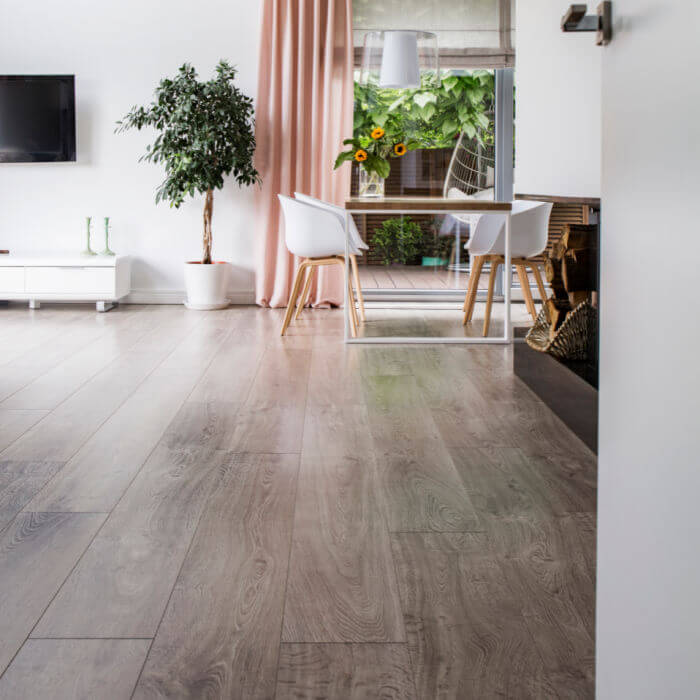Are you doing a flooring project?
Modernize can pair you with three to four pros in your area, so you can compare options and save time and money.
Vinyl and linoleum are similar flooring products. Both are easy to clean, fairly inexpensive, and easy to install or have installed. There are some differences in the material, maintenance, appearance, and installation that consumers should be aware of before committing to a purchase. Here is what you should know about linoleum vs vinyl.

Materials: What Are Linoleum and Vinyl Made Of?
Linoleum flooring is made from linoxyn, a solidified linseed oil, combined with tree resins, wood flour and cork dust. These natural, renewable, and biodegradable materials are perfect for consumers looking for environmentally friendly flooring.
Vinyl flooring is made from synthetic materials such as colored polyvinyl chloride (PVC) that is formed into sheets.
Cost of Linoleum vs Vinyl Floors
Linoleum is generally less expensive than wood or ceramic tile flooring, but will cost a bit more than vinyl at $2-5 per square foot.
Vinyl can start at $2-3 per square foot. This waterproof and fire-resistant product is durable, very low-maintenance, and inexpensive.
Maintenance: Is Vinyl or Linoleum Easier to Care For?
While easy to clean, linoleum floors do require some maintenance. Water damage can occur on linoleum, so it is important to apply an annual acrylic coating to protect the floor from the inevitable splashes in a kitchen or bathroom.
Because it is only water resistant and not water-proof, linoleum flooring is not the best choice for areas with high moisture and humidity. Durable linoleum typically lasts for 20-40 years, but the natural elements of this type of flooring can also be more sensitive to harsh chemicals in cleaners. Rips and tears can be replaced with a patch from remnants of the original sheet.
Vinyl floors are completely waterproof. No seal or coating is necessary and any floor cleaner can be used. This impervious material will endure splashes and spills in the bathroom and kitchen.
Find the Right Contractor for Your Flooring Project
Whether you’re ready to begin your project now or need some expert advice, our network of contractors are here to help. With a few simple questions, we’ll find the best local professionals for you
Appearance of Linoleum vs Vinyl
The design of a linoleum floor is created by adding layers of color. Because the colors run deeper than the surface, the design will withstand years of wear and tear. As the surface begins to wear down, new color granules are revealed, which is why this flooring material lasts for such a long time. There are countless color options available in this material, making it a versatile fit for any room and décor.
If you have fallen in love with the look of natural flooring options like hardwoods, but do not have the budget for them, vinyl floors can be designed to mimic them.
Installation
Vinyl flooring is available in sheets or in square tiles. Homeowners often choose vinyl tile or plank flooring as a DIY project because it is very simple to install. Installing your own vinyl tiles is a very cost-effective way to replace flooring. The tiles are inexpensive and there is no need to pay for an installer.
If you choose linoleum or vinyl sheets, however, it may be wise to let a professional tackle it. Precise measurements and skillful cuts are required to ensure the sheet fits the room exactly right. Linoleum also requires a careful application of sealant to protect against water damage.
VOCs in Vinyl or Linoleum
VOCs are Volatile Organic Compounds. These are chemicals released into the air that can cause respiratory issues. When flooring products contain VOCs, there is a concern that the VOCs are trapped in interior rooms, stagnating and creating a long-term health risk.
Vinyl flooring emits a small amount of VOCs. However, many flooring manufacturers have developed eco-friendly vinyl sheets that emit lower levels of VOCs.
Both vinyl and linoleum flooring will require an adhesive. This can contain high levels of VOCs. Concerned consumers can opt for a low-VOC adhesive for the installation process.
The differences between vinyl and linoleum flooring should be enough to help sway you one way or the other. Is your primary concern the environmental impact of the flooring? Then linoleum is clearly the way to go.
If, however, you are in need of remodeling on a tight budget? Then inexpensive vinyl will meet your needs without sacrificing beauty. Both flooring options offer a huge variety of colors and patterns at a fraction of the cost of hardwood or stone.
Find the Right Contractor for Your Flooring Project
Whether you’re ready to begin your project now or need some expert advice, our network of contractors are here to help. With a few simple questions, we’ll find the best local professionals for you
Reviews from Real Homeowners
Welcome to Homeowner Resources! We are the Modernize blog. Modernize pairs more than 3 million homeowners a year with pre-vetted contractors in their area. This blog started because we believe homeowners should know everything about their homes, from how their HVAC works to which front door colors they might love. On Homeowner Resources, you can find information on every part of your home, right down to how you can negotiate with contractors to get the best price. Here's more about the blog.
Need a contractor? Learn more about how Modernize finds the right pro for you.


